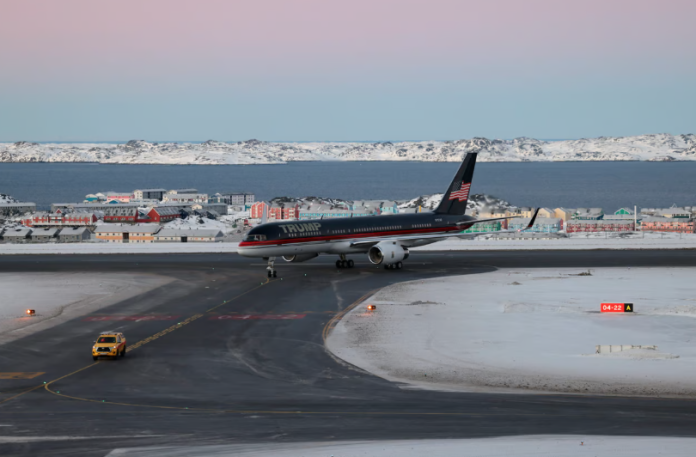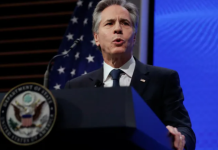
The main protector of Greenland against an attack is … the United States.
In 1951, the United States signed an agreement with Denmark pledging to protect Greenland from attack. Fast-forward 74 years, and the threat is now coming from America.
This week, incoming U.S. President Donald Trump sent shockwaves across Europe when he refused to rule out using military force to annex the world’s largest island, an autonomous territory of 57,000 people that is part of the Kingdom of Denmark.
Trump, who also floated the idea of the U.S. taking over Canada and the Panama Canal, has long had his eye on Greenland — a strategically located island rich in minerals and oil.
While there is little question as to which country would win in a fight, Denmark might have a better chance if it turned to the lawyers. Copenhagen could ask them whether the EU is somehow required to defend Greenland; whether it could invoke NATO’s common defense provisions against an attack by the alliance’s own largest member; and what Washington’s obligations are under the 1951 treaty.
The U.S. has — by far — the world’s largest defense budget, spending $948 billion last year. Its armed forces have 1.3 million personnel — some of them currently stationed in Greenland. Denmark, for its part, last year spent $9.9 billion, has only 17,000 soldiers, and most of its heavy land-warfare equipment has been donated to Ukraine.
If Trump did make good on his threat to annex Greenland by force, “that would be the shortest war in the world, there is no defensive capacity in Greenland. The Americans were in charge,” said Ulrik Pram Gad, a senior researcher at the Danish Institute for International Studies.
Some Danish coastguard ships frequent southeastern Greenland, but the Danish press has reported that the software needed to shoot at targets was never bought and installed, he added.
Pram Gad said he was perplexed by Trump’s intentions. “Is that bravado? Is that threat diplomacy between allies? We don’t really know, but that’s going to be the mode for the next four years.”
Top officials, including Danish Foreign Minister Lars Løkke Rasmussen and his outgoing U.S. counterpart Antony Blinken, initially dismissed Trump’s comments.
However, Danish Prime Minister Mette Frederiksen organized a meeting with party leaders on Thursday to discuss the issue, while Rasmussen backpedaled on his initial nonchalant reaction. “We are taking this very seriously, but we don’t have any ambition to escalate a war of words with a president that is on the way into the White House,” he said.
Unfit to fight an invasion
Under the 1951 pact, the U.S. accepted the legal obligation to defend against any attack on the massive Arctic island, given the inability of the Danish armed forces to fight off a potential aggressor without help.
“Denmark has been very aware it cannot defend Greenland against anybody on its own,” said Kristian Søby Kristensen, a senior researcher at the University of Copenhagen’s Center for Military Studies. If Trump did try to seize the territory by force, “the question is: Who would [the Americans] be fighting? Their own military? They’re already there,” he added.
The U.S. significantly reduced its military presence on the island after the Cold War ended, but an early warning radar station remains at the Pituffik space base in the northwest of Greenland. It’s a key asset that can spot spacecraft and ballistic missiles, including potential nuclear warheads launched by Moscow.
Meanwhile, Denmark’s armed forces are neither equipped nor trained to resist a U.S. invasion. They “have been taking care of more mundane peace-time military activity,” explained Søby Kristensen, and regularly deploy maritime patrol aircraft and ships in Greenlandic waters.
In December last year, Danish Defense Minister Troels Lund Poulsen announced a new defense-spending package worth a “double digit billion amount” in krone to buy two long-range drones, two dog sled patrols, and two inspection ships. The money was also to fund the hiring of more people for Denmark’s Arctic Command in the capital, Nuuk, and an upgrade to Kangerlussuaq Airport to make it fit for F-35 fighter jets.
That push was prompted by U.S. demands, including from Trump during his first term, according to Marc Jacobsen, an associate professor at the Royal Danish Defence College.
When Trump first floated the idea of buying Greenland in 2019, “that was part of a U.S. strategy to get Denmark to spend more of [its] military budget on surveillance of Greenland,” he said.
Pen vs. the sword
Although Denmark’s armed forces are much smaller than those of the U.S., Copenhagen is nonetheless among those European capitals that have taken the need for a defense ramp-up very seriously since the war in Ukraine began.
Denmark spent 2.37 percent of its GDP on its military last year — above NATO’s 2-percent target — and is planning further increases. The Danish air force is replacing its F-16 fleet with modern U.S.-made F-35 fighter jets, and is currently looking to procure air-defense systems.
However, Denmark has also significantly depleted its own arms stocks by giving artillery systems and tanks to Kyiv, arguing that unlike the Ukrainians, the Danes don’t face a direct threat from a hostile imperialist power.
Regardless, the donated military equipment would be of little use in defending Greenland against a U.S. invasion. “The only way to act there is in air or by sea. Land warfare makes very little sense in Greenland,” Søby Kristensen said.
If Copenhagen were to resist by relying on rules and laws, it could ask the EU for help.
On Wednesday, French Foreign Minister Jean-Noël Barrot said the European Union wouldn’t let a land grab happen — but it’s unclear whether Copenhagen would actually be able to lean on the EU for military assistance.
In case of an “extremely theoretical” U.S. invasion of Greenland, the EU’s mutual-assistance clause in Article 42 (7) of the Treaty would apply, a European Commission spokesperson told reporters this week.
However, the clause “is meaningless in its current form as there is no genuine military force behind it,” wrote Daniel Fiott, with the Centre for Security, Diplomacy and Strategy at the Brussels School of Governance.
It’s also unclear whether Denmark, a founding member of NATO alongside the U.S., could invoke Article 5 — the Alliance’s mutual-assistance clause — against another ally.
“You would essentially have a NATO member annexing the territory of another NATO member. So it would be pretty uncharted territory,” said Agathe Demarais, senior policy fellow at the European Council on Foreign Relations. “When you think about it, it doesn’t make any sense.”





















